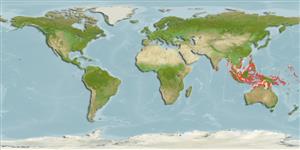>
Ovalentaria/misc (Various families in series Ovalentaria) >
Pomacentridae (Damselfishes) > Pomacentrinae
Etymology: Amblypomacentrus: Greek, amblys = darkness + Greek, poma, -atos = cover + Greek, kentron = sting (Ref. 45335).
More on authors: Schlegel & Müller.
Environment: milieu / climate zone / depth range / distribution range
Sinh thái học
Biển Cùng sống ở rạn san hô; không di cư; Mức độ sâu 2 - 35 m (Ref. 9710). Tropical; 23°N - 15°S
Western Central Pacific: East Indies, Philippines, New Guinea, New Britain, Solomon Islands, and Egum Atoll (Solomon Sea).
Bộ gần gũi / Khối lượng (Trọng lượng) / Age
Maturity: Lm ? range ? - ? cm
Max length : 8.5 cm TL con đực/không giới tính; (Ref. 48636)
Các tia vây lưng cứng (tổng cộng) : 13; Các vây lưng mềm (tổng cộng) : 11 - 12; Tia cứng vây hậu môn: 2; Tia mềm vây hậu môn: 12 - 13.
Adults inhabit lagoon and coastal areas (Ref. 9710). Found in sandy or silty areas around outcrops of rubble on sand, mud, sponge or rocks. Occur singly or in small groups. Young often with anemones for protection (Ref. 48636). Oviparous, distinct pairing during breeding (Ref. 205). Abandoned shells and waste bottles serve as nests (Ref. 90102). Eggs are demersal and adhere to the substrate (Ref. 205). Males guard and aerate the eggs (Ref. 205).
Life cycle and mating behavior
Maturities | Sự tái sinh sản | Spawnings | Egg(s) | Fecundities | Ấu trùng
Oviparous, distinct pairing during breeding (Ref. 205). Eggs are demersal and adhere to the substrate (Ref. 205). Males guard and aerate the eggs (Ref. 205).
Allen, G.R., 1991. Damselfishes of the world. Mergus Publishers, Melle, Germany. 271 p. (Ref. 7247)
IUCN Red List Status (Ref. 130435)
Threat to humans
Harmless
Human uses
Các công cụ
Special reports
Download XML
Các nguồn internet
Estimates based on models
Preferred temperature (Ref.
123201): 27.4 - 29.3, mean 28.8 °C (based on 1662 cells).
Phylogenetic diversity index (Ref.
82804): PD
50 = 0.6250 [Uniqueness, from 0.5 = low to 2.0 = high].
Bayesian length-weight: a=0.01479 (0.00642 - 0.03409), b=3.00 (2.80 - 3.20), in cm total length, based on LWR estimates for this (Sub)family-body shape (Ref.
93245).
Mức dinh dưỡng (Ref.
69278): 2.7 ±0.3 se; based on size and trophs of closest relatives
Thích nghi nhanh (Ref.
120179): Chiêù cao, thời gian nhân đôi của chủng quần tối thiểu là dưới 15 tháng (Preliminary K or Fecundity.).
Fishing Vulnerability (Ref.
59153): Low vulnerability (10 of 100).
Nutrients (Ref.
124155): Calcium = 136 [77, 226] mg/100g; Iron = 0.899 [0.565, 1.395] mg/100g; Protein = 18.6 [17.5, 19.6] %; Omega3 = 0.16 [0.10, 0.25] g/100g; Selenium = 23.5 [13.6, 41.9] μg/100g; VitaminA = 137 [48, 391] μg/100g; Zinc = 2.24 [1.57, 3.08] mg/100g (wet weight);
